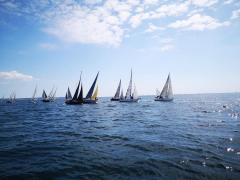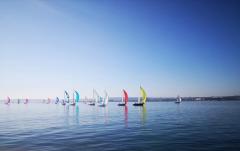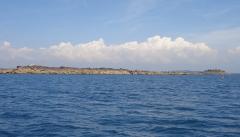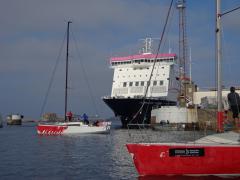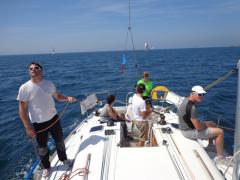Another very foggy trip back to Cherbourg was worth it in order to meet up with the crew of ‘Gwaihir Venturi’, a Dufour 34, and set out for Saint-Vaast and our second Tour des Ports de la Manche together. The first evening in Saint-Vaast meant catch-ups with friends from Le Havre and Granville, and it soon felt like no time had passed since our last meeting. This time, though there was the added interest of the World Cup for the various nationalities represented on the water.
The windward starts of the TdP races are very important, as they tend to dictate the processional order around buoys, rocks and headlands to come; thenceforward it is a matter of careful navigation and lots of local knowledge as the races move around the Cotentin peninsula and over to the islands.
Lack of wind meant we didn’t finish the first leg back to Cherbourg, and the second to Dielette had to be abandoned after a very slow start in the grande rade, which meant motoring up to La Hague and through the race, finding the wind off the Nez de Jobourg, so that the afternoon was spent doing a couple of ‘bananes’ in the spendid Anse de Vauville.
A ‘banane’ is the term for an Olympic-style race course, with a windward and an offset mark, similar to what we would call a ‘sausage’. With a light current crossing the course and a reasonably steady offshore breeze of around 10 knots, this was champagne racing, and ideal for the Dufour. The starts were busy, as the fleet of some 80 boats in 5 classes was divided into two, making for some noisy moments at the committee boat end, and we got squeezed out of the first start, which meant going round the committee boat and then starting up the right hand side in clean air as the herd continued across to the other side, putting us near the front at the first mark, so that a clean hoist gave us a very good finish.
In the second race we were fortunate with a gap which enabled us to tack on to port and do the same thing, except this time we needed to be inside a close rival and tacked across the middle of the course to make a port approach just shy of the buoy to slot in in front of them. Gybing into clean air for the downwind leg gave us good boat speed and the inside position before the leeward mark before hauling our wind across to the finish line in front of the opposition.
Dielette to Guernsey had the same windward leg off the beach to start, with a 20 mile spinnaker leg to follow, a short beat through a very soft moment from which we emerged well, and then another run in rough water down the east side of Sark, where we did a peel (bowman Pierre’s speciality) to have the reaching kite ready for the fast tight reach across to St Peter Port, and another win, for us and for the French football team playing Belgium – it got very loud in the tent, especially for the singing of the ‘Marseillaise’.
To find wind for the Guernsey to Carteret leg we had to motor across and through the passage to the south of Sark, with a start up to the Blanchard buoy off the east of the island and another long spinnaker reach to the mainland. A starboard windward mark in strong current caused lots of incidents and some damage, though we survived the day to claim a fourth, which was less encouraging. For the evening at Carteret a giant screen had been provided for everyone to watch the dismantling of English hopes by Croatia (in spite of Dele Alli’s designer falling over and Harry Kane’s carthorse kicking).
The following day another great first leg put us ahead for the spinnaker reach down round the Ecrehous, but the forecast calm off the south of Jersey left most of the fleet making their peace with the strong flood current among the rocks – we were among the many who had to kedge to wait for the return of a lively breeze which meant setting the sails and gaining enough speed before being able to get the anchor back as it trailed behind the boat! Again we finished fourth, which put us on equal points with rival Karibario from Granville.
The departure from St Helier was notable for the fact that the event organisers had finally remembered that ferries arrive and leave as we are trying to leave the harbour, and after being held back at the harbour mouth the fleet eventually gathered in St Aubyn bay for another short windward leg in very little wind, with a leftwards tendency in what there was, favouring the port end start. Karibario managed to get away above us on the buoy, but as the wind headed and it was necessary to tack to regain the port layline, we had the good fortune to catch them in a port-starboard encounter which we protested, and they argued, but then seemed to repeat with the next boat, leaving them no option but to do turns, which in a heavy boat in 5 knots of wind was going to be expensive.
The spinnaker run to the SE through the rocks meant the fleet opened out, and Karibario went deep into clean air and slowly caught us back up, and at the NE Minquiers cardinal they were level, but the race committee had decided to finish the race there for some curious reason, as we continued to hold the kite all the way to Granville. This put us in front of Karibario by two places, giving us first place in class in front of Karibario and old friends Les Rapetous, the piratical all-black Class 10 – the crew turned out for the prizegiving dressed in convict uniforms complete with chains!
In the next class the two Cherbourg Sigmas match-raced the week, with honours equal on the last day, though Marc and Thierry and their team on Carabot managed to inch ahead of Oirrior, the boat I normally sail on at Cherbourg.
Another great week, in the best weather and company imaginable, among the changing landscapes of the Cotentin and the Iles Anglo-Normandes, with a high standard of racing in some great waters. And then France went and won the World Cup!
A big thank-you to Philippe and Armelle and the rest of the crew for having me aboard again. Merci et à très bientôt!
Steve Fraser
Submitted on 17th July 2018
